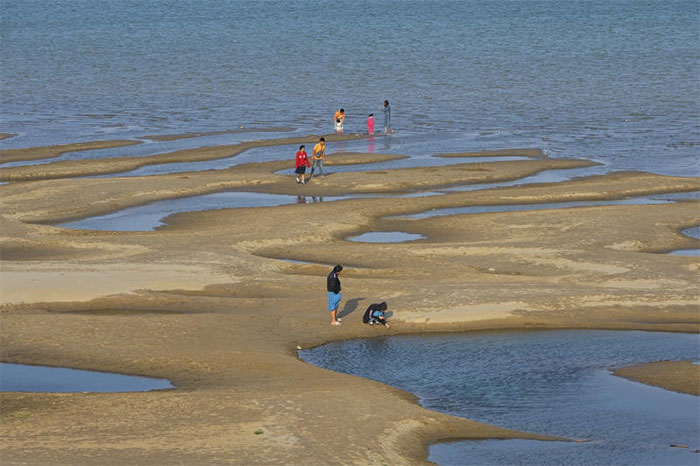The Mekong River changes from alluvial to blue
Experts say the Mekong has recently changed from the golden brown of alluvial sediments to turquoise. Although it attracts tourists out of curiosity, its cause makes many people nervous.
The Mekong River is usually yellowish-brown in color due to sediment flowing downstream from the stream. But recently it is clearly wearing a blue color that is a reflection of the sky. The water level also became abnormally low, revealing sandy beaches that allowed curious visitors to stand in the middle of the river.

The tourists stand on the sand of the Mekong River in Nakhon Phanom Province, northeastern Thailand on Wednesday, December 4.(Photo: AP).
Low water levels have affected fishermen and farmers, but experts say the depletion of sediment indicates another danger that can lead to riverbank and riverbed erosion. Experts determine the reason is that hydroelectric dams have contributed to both of these problems.
About 70 million people depend on the Mekong for water, food, trade, irrigation and transportation. Critics argue that large-scale hydroelectric dams have disrupted the region's ecosystem.
Pravit Kanthaduang, director of the fisheries office at Bueng Khong Long, a district in Bueng Kan province, Thailand, said the dam prevented many sediments from moving further downstream, making the water clear. Less sediment means less nutrition for plants and fish in the river, threatening ecological balance, he said.
Chainarong Setthachau, an expert at the Department of Social Sciences and Humanities, Mahasarakham University, who has studied changes in the ecology of the Mekong River in the past two decades, said that when there is little sediment, water is also abundant. more flow.
"A flow of less sediment will release energy to the banks of the river downstream. This 'hungry water' will cause more erosion for the banks, uprooting trees and damaging the engineering structures. River, " said Chainarong.
Dam developers have denied that they are responsible for the low water level that some critics associated with testing run generators starting in March. In October, Xayaburi Power Company said the project spent more than 19.4 billion baht (US $ 639 million) to minimize negative environmental impacts, including the construction of outlets for deep currents. and fish and fish. The total cost of the plant is 4.47 billion USD.
Fishing boats are moored on the Mekong River, where the river has turned green instead of the usual mud color, in Nakhon Phanom Province on Thursday, December 5.(Photo: AP)
Ms. Daeng Pongpim, a fisherman from Ta Mui village, Ubon Ratchathani province, said: "I am 67 years old and have never seen anything like this before. The thing that concerns me most is the low water level. Right now, at the beginning of winter, the water level cannot be this low, I cannot imagine how hard we can be during the peak days of the dry season, in March and April. next year".
Another fisherman, Chaiwat Parakun, said he gave up his fishing gear a few years ago because of the reduced fish stock and turned to a tourism business.
- Phenomenon "dragon spraying shadow" on the Mekong
- Giant fishes of the Mekong
- New discovery of the process of forming the Mekong River
- Small dams threaten fish species on the Mekong River
- Reduce the environmental impact of the Mekong River
- Thailand studies a flow of a tributary of the Mekong
- More than 87.3 million USD to overcome the disaster of Mekong River
- 'Should postpone dam construction on the Mekong for 10 years'
- It is proposed to postpone the construction of a dam on the Mekong River
- Smashing the Mekong River
- Emergency news on the Mekong River
- No decision has been made on Lao hydroelectric dam
- Lessons from Thailand for dams on the Mekong River
- The US supported the postponement of the construction of the Lao hydroelectric dam
 Is the magnetic North Pole shift dangerous to humanity?
Is the magnetic North Pole shift dangerous to humanity? Washington legalizes the recycling of human bodies into fertilizer
Washington legalizes the recycling of human bodies into fertilizer Lightning stone - the mysterious guest
Lightning stone - the mysterious guest Stunned by the mysterious sunset, strange appearance
Stunned by the mysterious sunset, strange appearance